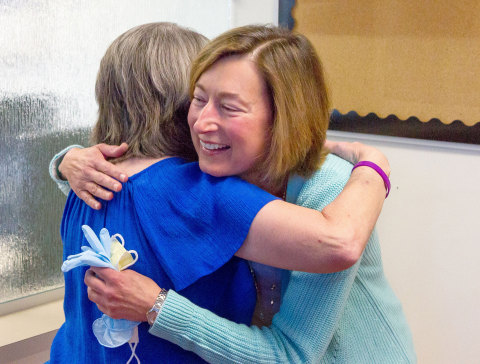STANFORD, Calif.--(BUSINESS WIRE)--Tammy Griffin had the rare opportunity to hear her heart beat in another person’s chest on March 17. Griffin had donated her heart to Linda Karr on Feb. 1, after receiving a new heart and lungs from a third donor, in an exceptionally uncommon procedure known as a heart-lung-heart domino transplant.
Organs available for transplant are in short supply. Heart-lung combinations are even more rare because a set of heart and lungs is usually split up so that the organs can benefit two people instead of just one. Domino transplantation of a heart-lung and heart does, however, benefit two people. A highly unusual procedure, it has only been performed at Stanford eight times before, last in 1994.
For Griffin, receiving a heart-lung combination was critical. Diagnosed with cystic fibrosis before she was a year old, Griffin’s lung capacity had diminished so much that she was on oxygen full time, unable to do much at all.
Her heart, however, was still functioning well. “Her heart was an innocent bystander pushed out of its normal position in the middle of the lungs as her right lung shrank and the left one expanded,” said heart surgeon Joseph Woo, MD, a cardiothoracic surgeon at Stanford Health Care who oversaw and coordinated the surgical teams that conducted the domino procedure. That displacement made it impossible for Griffin to have only new lungs connected, said Woo, professor and chair of cardiothoracic surgery at the Stanford University School of Medicine.
Meanwhile, Karr’s heart was on the decline. Karr was diagnosed almost 20 years ago with right ventricular dysplasia, a genetic disease that causes a dangerously abnormal heart rhythm. Over time, it became difficult for her to walk down a hall at work without having to stop and rest, and impossible to walk her dog. Even so, she wasn’t very high on the transplant waiting list.
“My doctor told me I’d have to be hospitalized to move up—and if my deterioration was rapid, I might not get a heart in time,” she said. Then, on Saturday, Jan. 30, she turned on her phone after coming out of a movie theater. The phone rang. It was a Stanford doctor: A possible heart donor had been found, and he would call back in four hours. She checked in to Stanford Hospital the following day.
During the Feb. 1 domino procedure, one surgical team removed the heart and lungs from the deceased donor, a second team implanted them in Griffin, and a third team implanted her heart in Karr. (Woo led the second team.)
Other Stanford Medicine physicians, including Michael Fowler, MD, director of the Heart Failure Program, and Gundeep Dhillon, MD, medical director of the Heart-Lung and Lung Transplantation Program, provided pre-transplant care to Griffin and Karr and are providing post-transplant care to them, as well.
“The extraordinary work of Dr. Woo and his team demonstrates the very best of an academic medical center—where our research informs the development of revolutionary treatments like the domino procedure, which we then use to save the lives of our patients,” said Lloyd Minor, MD, Carl and Elizabeth Naumann Dean at Stanford Medicine.
On March 17, the two women met for the first time, with their families and Stanford Medicine doctors looking on. Both women are recovering, and grateful for the generosity of the donor and his family who set the life-saving domino transplant in motion.
Karr is also grateful for Griffin’s generosity. “I feel as though a world of possibilities open up now for my future, kind of a second chance in life,” Karr told her.
“Me, too. I feel the same way,” Griffin responded. Karr promised Griffin she’d take good care of her new heart, and then added, “Even though we were strangers before today, you’ll always be part of me.”
Woo, who also holds the Norman E. Shumway Professorship in Cardiovascular Surgery, hopes to see an increase in the number of organ donors. “This story highlights how scarce organs are today,” said Woo. “People are waiting and dying on those transplant lists. We would like to see that change.”
About Stanford Health Care
Stanford Health Care seeks to heal humanity through science and compassion, one patient at a time, through its commitment to care, educate, and discover. Stanford Health Care delivers clinical innovation across its inpatient services, specialty health centers, physician offices, virtual care offerings and health plan programs.
Stanford Health Care is a leading academic health system and part of Stanford Medicine, which includes the Stanford University School of Medicine and Lucile Packard Children's Hospital Stanford. Stanford Medicine is renowned for breakthroughs in treating cancer, heart disease, brain disorders and surgical and medical conditions. For more information, visit: www.stanfordhealthcare.org.




